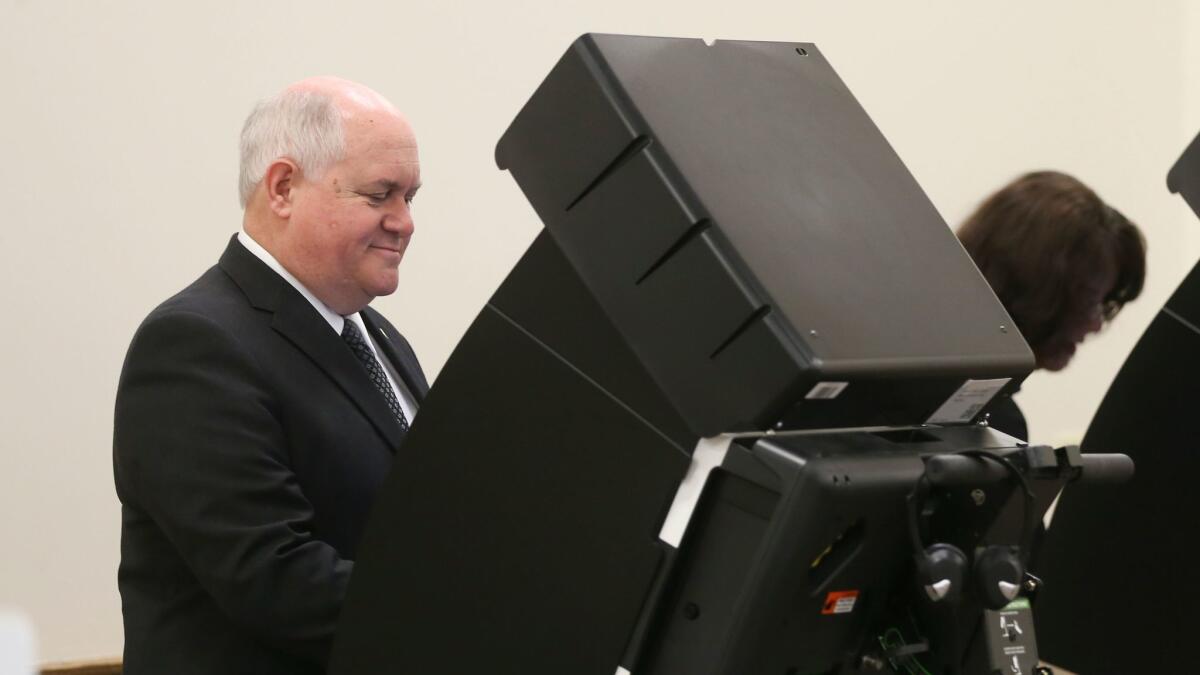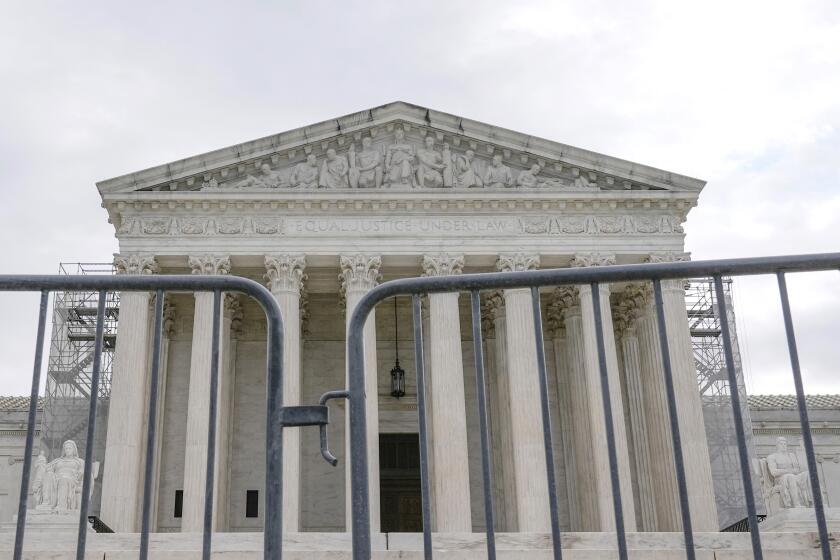Republicans win a special House election in Kansas after an embarrassing red-state scare

Republicans survived an embarrassing scare and narrowly held on to a Kansas congressional seat Tuesday in a special election that served as a surprising red-state referendum on President Trump.
The single-digit victory for state Treasurer Ron Estes marked a far closer race than Democrats have pulled off in recent years, giving the party bragging rights as it looks to a series of special House elections this year.
Estes trailed in early tallies but then began to build a lead over Democratic civil rights attorney James Thompson, who had sought to translate anti-Trump anger on display at rallies and town halls across the country into a victory in one of the nation’s unlikeliest places. With 100% of precincts reporting, Estes led 53% to 46%.
The 4th District race in the Wichita area was the first of a series of elections spurred by vacancies created when Republican House incumbents moved to the Trump Cabinet. The Kansas seat was held by Mike Pompeo, who resigned in January to take the job of CIA director.
The Kansas seat always ranked as a long shot for the Democrats, since the state has been ruby-red for decades and the seat has been held by a Republican since 1994. Trump carried the district in November in a 60%-33% swamping of Hillary Clinton. Pompeo won with a similar 61% of the vote in November.
Both Democrats and Republicans treated a GOP win as a foregone conclusion until recently, when Republicans were shocked into action. The combat continued until election day, when the president tweeted out a request for his supporters to show up at the polls.
“Ron Estes is running TODAY for Congress in the Great State of Kansas. A wonderful guy, I need his help on Healthcare & Tax Cuts (Reform),” Trump tweeted.
Nearly three months into his presidency, Trump has played the role he did in the campaign: a polarizing figure who inspires both rabid support and angry disapproval. The Kansas race showed that, for the moment, disapproval has more momentum.
The period between Trump’s romping November victory and election day Tuesday has been a rocky one for the president. His immigration executive order, one of his campaign’s most vehemently stated promises, was blunted by the courts and prompted protests across the country.
More recently, a recalcitrant and ideologically split Republican Congress could not come to agreement over a path to repeal and replace President Obama’s healthcare program, leaving Trump unable to sign any measure to secure another of his highest-profile campaign pledges.
The successful ushering in of new Supreme Court Justice Neil M. Gorsuch, a clear administration success, has been partly overshadowed by continuing investigations into whether Trump or his team worked with Russian entities to harm Clinton’s presidency, another factor that Democrats hoped would depress Republican enthusiasm.
The Kansas race also appeared to be affected by the extreme unpopularity of the state’s Republican governor, Sam Brownback. His tax cuts, to which Estes, as the state Treasurer, was unofficially attached, have left the state with big budget problems.
More recently, Brownback vetoed an effort by state legislators, including moderate Republicans, to insure tens of thousands of Kansans by expanding Medicaid under the auspices of Obamacare.
A Morning Consult poll released Tuesday listed Brownback as the second-most unpopular governor in the country, with 27% of Kansans approving of him. Only New Jersey Gov. Chris Christie was less popular, with 25% support in his state.
“Estes appears to be swept up in a last-minute vortex of factors outside his control: Democrats’ anger towards Trump, independents’ anger towards Gov. Sam Brownback and GOP dissatisfaction with early administration failures,” David Wasserman, an analyst for the nonpartisan Cook Political Report, wrote Monday.
The outcome of the race had no appreciable impact on control of the House, where Republicans have a comfortable lead over Democrats, 237 to 193.
But it was a first test of whether Democrats could translate anti-Trump sentiment into a punitive verdict.
Apart from the fact that Republicans outnumber Democrats in the district by nearly 2 to 1, the congressional race represented Kansas’ best-case scenario for Democrats and worst-case for Republicans.
Democrat Thompson presented himself as someone who, due to his poverty-filled upbringing, had felt the pain of economically threatened Kansans. That made him the antithesis of a party often defined by coastal elites disconnected from the troubles of middle America.
Estes was swept into state office in 2010, along with Brownback, but has not struck an independent posture since and is “largely not known for anything in particular,” said Edward Flentje, professor emeritus at the Wichita State University School of Public Affairs.
Estes also seemed not to immediately anticipate the relative strength of the Democratic challenge.
“It’s been a lackluster campaign and he’s done a kind of conventional approach to the election,” Flentje said of Estes. Thompson, he said, had gotten his story across “to anybody who pays attention.”
The late-campaign push by Republicans included a Monday visit by Texas Sen. Ted Cruz, more than $100,000 in money from national Republicans and their allies, and robo-calls into the district from Trump, Vice President Mike Pence and former Kansas Sen. Bob Dole.
The attention was unlike anything seen in the state, where Republicans are usually expected to win as easily as Democrats do in places like California.
“All of this is a bit surprising,” Flentje said. “I can’t ever remember getting a robo-call from the president in Kansas.”
Nationally, the political focus now turns to next Tuesday’s special election in Georgia, where in a far more centrist district Democrat Jon Ossoff is trying to escape a runoff by gaining a majority against a host of squabbling Republican candidates.
That 6th District seat was held until recently by Republican Tom Price, who is now Trump’s secretary of Health and Human Services.
The district went for Trump in November, but only by single digits, raising Democratic hopes of another boost before the important 2018 elections. With only weeks of planning, Ossoff raised millions in cash at a rate usually accomplished only by veteran fundraisers.
cathleen.decker@latimes.com | Twitter: @cathleendecker
ALSO
White House press secretary apologizes for saying Hitler didn’t use chemical weapons
Updates on California politics
UPDATES:
9:55 p.m.: Updated with results from 100% of precincts.
This article was originally published at 8:30 p.m.
More to Read
Get the L.A. Times Politics newsletter
Deeply reported insights into legislation, politics and policy from Sacramento, Washington and beyond. In your inbox three times per week.
You may occasionally receive promotional content from the Los Angeles Times.







